Text
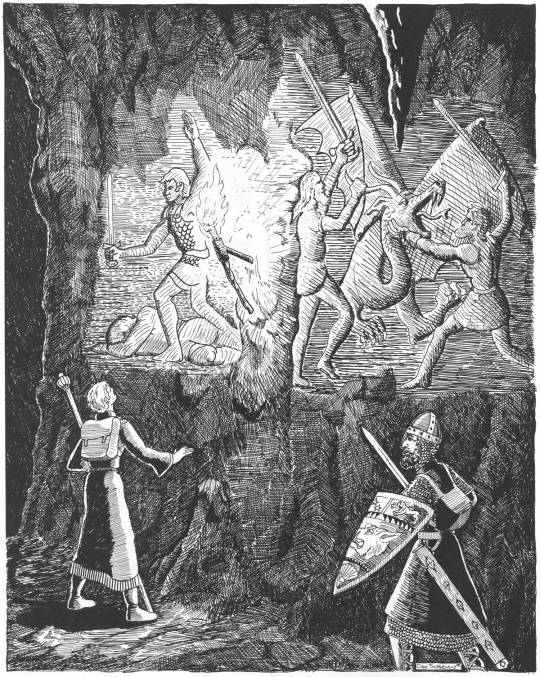
The walls of the grand entry cavern are carved with scenes of frost giants battling enemies, and hunting dragons and other fearsome monsters. (David Sutherland, AD&D module G2: The Glacial Rift of the Frost Giant Jarl by Gary Gygax, TSR, 1978)
#D&D#Dungeons & Dragons#David Sutherland#AD&D#The Glacial Rift of the Frost Giant Jarl#dungeon#giant#dragon#frost giant#giants#dnd#Dungeons and Dragons#TSR#Gary Gygax
254 notes
·
View notes
Text
No. 2 - G2, The Glacial Rift of the Frost Giant Jarl (July 1978)
Author(s): Gary Gygax Artist(s): Erol Otus, Dave C. Sutherland III, David A. Trampier (cover) Level range: Average of 9, preferably 5+ players Theme: Standard Swords and Sorcery Major re-releases: G1-3 Against the Giants, GDQ1-7 Queen of the Spiders, Against the Giants: The Liberation of Geoff, Dungeon #199, Tales from the Yawning Portal
On the heels of being more impressed with G1 than I expected, will G2 be similarly impressing? Time to find out!
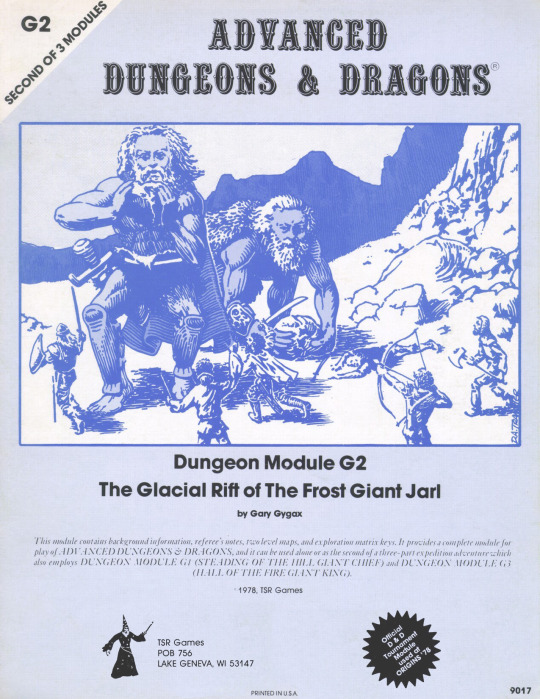
The intro blurb is mostly a repeat of the text of G1, including admonitions that running stock is for villains. Our motivation remains: figure out why the hill giants did that, no matter how fucking dangerous it is. Interestingly, the other main objective of G1 (give 'em a bloody nose) is not relevant here, because that teleport means that the frost giants aren't a threat to the villagers themselves. In fact, the room teleportation schtick kind of means G2 is filler? Like, the big reveal that the G series leads to the D series is not really impacted by the events of G2. So, oops!
Conveniently, the magical chain teleports out outside the rift so you can once again have a secret cave HQ. I feel like you have a responsibility as a GM to have a giant counterattack to at least one of these caves.

I really like the imagery of the descent into the rift here. I mean, I don't think this illustration really does it justice, imagining the deep blue color of light barely passing through the ice and how that gives the area beneath the surface an eerie oceanic glow at all times other than noon -- that's some good vibes. Gary opts for green, which is a fair enough choice. Unfortunately, Gary is more interested in simulating the mounting climbing than vibes, which means that at least one of your party members is going to fall face first into the snow drift below. Gary "generously" caps the damage at 10d6 (avg 35 dmg) -- a level 9 fighter, to be clear, has 9d10 hp (avg 45 hp) and a level 9 magic user has 9d4 hp (avg 23), so that's not ideal. Also recall that you recover 1hp per full day of rest normally, so if you fall and survive you're probably still fucked unless your cleric has a lot of spells left. I'm also pretty sure your cave HQ is above the cliff face, so, risking the descent seems like suicide to me. You're going to lose people and even leaving to heal them back up is simply taking another chance at oblivion. Take the stairs.
If you have the audacity to slow fall down, you will be blown 75ft off course in a random direction. Very cool Gary!
Another interesting detail: monsters in classic DND have a pretty short attention span and will lose you fairly quickly if you flee around a corner. This is particularly amped up here to a breezy 4 in 6 odds of success, due to blizzards blocking chase.
Anyway, we're into the room by room, so let's do some room by room shit.
There is a kind "spiked heads of our enemies at the gates" situation, with corpses mutilated and frozen in transparent ice as a warning to not intrude. Honestly that's badass. What's not badass is if the players have the wherewithal to try and free the corpses (for loot or kindness), most routes lead to the treasure being destroyed and the roof collapsing -- probably instantly killing your squishies.
The hill giants from G1 are lolling about waiting for an audience, so points for continuity. I have to imagine they're freezing their asses off, though.
There are yetis here? Which, going on the graphic and the listed intelligence score in the MonMan, I have to conclude are sentient bipedial apes but like, NOT like the Frost Giants. Actually apparently the average yeti is smarter than the average frost giant, so I guess it's a Diogenes situation where they choose to live in a shitty cave when everyone else has a nice cave?
The 5 hill giants visiting the Jarl have 1k to 6k gold fur cloaks, which like. Imagine a 6,000 gold cloak. Not only is it got to be huge (Hill Giants are 10.5ft tall), for it to be worth 6k to a vendor that's got to be a one-piece fabric cloak off a particularly rare and good condition animal. I guess the players could use it as the world's fanciest comforter?

The official appearance of a Remoraz! These are awful creatures. They swallow you whole and then superheat their insides to cook you. Nasty side effect: its outsides become furnace-hot and destroy nonmagical items and burn people to death. Look at this horrible thing! And of course it's guarding the swankiest loot to date -- a +2 Giantslaying Sword and a 3 Wishes Ring. It's been a weird trend lately that the best loot is, not owned by the leader of the Giants? The best hoard seems to always belong to Some Guy. Naturally this awesome loot "sinks into the ice" if you use a fireball, because this adventure has an addiction to telling the wizard to fuck off. Note that the sword being lost punishes the fighter for the magic users' decision. Note also that the Remoraz going into superheat mode doesn't do the same thing? It sucks. This clause sucks. Cut it. The actual room itself is kind of neat, the implication is that the Remorhaz melted a spherical hole into the ice to make a den, which is awesome.
Another iconic Garyism: ". They have had audience with the Jarl, and after a special wassail to be held on the morrow they will depart for home with a treaty scroll." Translation: They're goin to have a drinking party tomorrow to celebrate a treaty signing.
And like, one room later, we get "leman", which means lover, and "durance vile", which means long imprisonment. The text implies that basically, she's a hot butch storm giantess being held in chains until she agrees to fuck the Jarl. Gary, simply ask a tall woman out. You don't have to be weird about it.
Rather than torches, the feast hall is lit with jarred fire beetles, which is kinda cute
There is a thick iron bar that "transports whosoever is standing on the floor to the entrance of Snurre's Hall [G3]". The iron bar is a lever, obviously, but is this a lever-operated teleporter? An elevator that goes straight down? G3 eliminates the elevator theory, since apparently you can arrive here via pegasus and there are caves one can access overhead. So it's a literal teleporter, and at least how I'm reading it makes it sound more science fiction than magic. Weird.
On the whole, G2 is a massive step down from G1. G2 lacks the factionalism of G1, punishes players for damn near anything attempted, and is broadly less imaginative than G1. It's a pity, really, because it's a far more interesting locale on paper, but the reality is that you could generate a cave like this by scribbling randomly. Meh. Next time we poke G3, and hope hope hope that it's more like G1 than G2.
16 notes
·
View notes
Text
50. Gary Gygax - G1: Steading of the Hill Giant Chief (1978)

The first official adventure module published by TSR, it is the first of many, many such modules, now that Gary Gygax finally realised that people wanted these modules. He wrote this as a way to take a break between writing the Monster Manual and the Player's Handbook so it actually came out before we even had a PHB for AD&D.

This is a very barebones adventure, clocking in at some 8 pages, but it's still a beloved adventure, frequently coming very high on "best adventure" lists and this is not only due to a nostalgia or historical factor. This is an adventure that rewards lateral thinking and planning, as the adventurers have to raid a Hill Giant Fortress inhabited by a large number of giants and their servants/slaves, if they go in "guns blazing"... well "swords blazing"... this is going to be a hard adventure to get through. The feasting hall near the entrance is chock-full of powerful giants and even a cave bear which will leave a party either dead or severely depleted before they even get to the dungeon level. Sneaking around is definitely the smart option here, also seeing as the treasure is mainly in treasure rooms and armories and not with the giants themselves. Remember that in early AD&D most XP came from treasure and not killing monsters.

As the PCs get to the dungeon level they will uncover a number of potential allies that they should really use to facilitate their progress an by the end of the adventure they will have a pointer towards the next part of the campaign, G2's The Glacial Rift of the Frost Giant Jarl, which we will cover next post. A great start to a long and influential campaign in only 8 pages! Well done Gary.
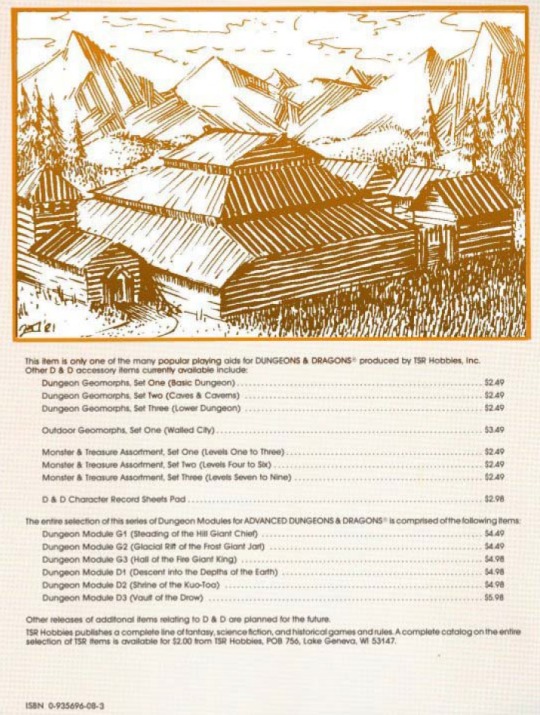
19 notes
·
View notes
Text
Dnd explained Frost Giants
Gigantic reavers from the freezing lands beyond civilization Frost giants are fierce hardy warriors that survive on the spoils of their raids and pillaging. They respect only brute strength and skill in battle demonstrating both with their scars and the grisly trophies they take from their enemies.
Frost giants are creatures of ice and snow. Their hair and beards are pale white or light blue matted with frost and clattering with icicles. Their flesh is as blue as glacial ice.
Frost giants dwell in high peaks and glacial rifts where the sun hides its golden head by winter. Crops don't grow in their and they keep little livestock beyond what they capture in their raids against civilized lands. They hunt the wild game of the tundra and mountains but don't cook it since meat from a fresh kill tastes sufficiently hot to their palate.
The war horns of the Frost giants howl as they march from their ice fortresses and glacial rifts amid the howling blizzard. When that storm clears villages and steadings lay in ruins ravens descending to feed on the corpses of any creatures foolish or unlucky enough to stand in the giants path.
Inns and taverns suffer the brunt of the damage their cellars gutted and their casks of ale and mead gone. Smithies are likewise toppled their iron and steel claimed. Curiously undisturbed are the houses of moneylenders and wealthy citizens for the reavers have little use for coins or baubles. Frost giants prize gems and jewelry large enough to be worn and noticed. However even those treasures are most often saved for trading opportunities with other giants more adept at crafting metal weapons and armor.
Frost giants respect brute strength above all else and a Frost giants place in the ordning depends on evidence of physical might such as superior musculature scars from the bodies of slain enemies. Tasks such as hunting childbearing and crafting are given to giants based on their physical strength and hardiness.
When Frost giants of different clans meet and their status is unclear they wrestle for dominance. Such meetings are might resemble festivals where giants cheer on their champions making bold boasts and challenges. At other times the informal ceremony can become a chaotic free for all where both clans rush into a melee that fells trees shatters the ice on frozen lakes and causes avalanches on the snowy mountainsides.
Though Frost giants consider the menial crafting of goods beneath them carving and leatherwork are valued skills. They make their clothing from the skins and bones of beasts and carve bone or ivory into jewelry and the handles of weapons and tools. They reuse the weapons and armor of their smaller foes stringing shields into scale armor and lashing sword blades to wooden hafts to make giant sized spears. The greatest battle trophies come from conquered dragons and the greatest Frost giant jarls wear armor of Dragon scales or wield picks and mauls made of a Dragon's teeth and claws.
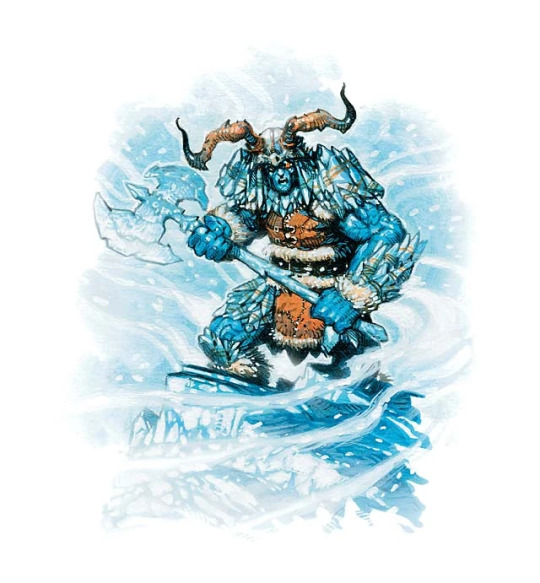
1 note
·
View note
Photo






AD&D “Giant” line, with original front/back covers
#ad&d#dnd#dnd5e#david trampier#david sutherland iii#rpg#tabletopgames#steading of the hill giant chief#the glacial rift of the frost giant jarl#hall of the fire giant king
13 notes
·
View notes
Photo

22 notes
·
View notes
Photo




G2: The Glacial Rift of the Frost Giant Jarl is the sequel to the G1: Steading of the Hill Giant Chief. If you played the first one, you likely got to this one by grabbing a magical chain and – poof – getting teleported to the snowy wastes. Who cares about rest and recovery when there’s more monsters to kill, right?
Glacial Rift is maybe my favorite of the three giant modules. It is, again, shockingly thin at eight pages. Where Steading featured earthy monsters like orc, trolls and carrion crawlers, everything here fits into the theme of “cold” monsters. Gygax was a big proponent of this kind of ecology, trying to populate dungeons with monsters that could co-exist. It works to a certain point – I can see frost giants sharing space with yeti and winter wolves, but why house a rhemoraz or tolerate white puddings? Just because they all live in the cold, doesn’t mean it makes sense for them to live together. Still, it was a step in the right direction and eventually led to believable dungeon ecologies that would appear in later D&D products, like Dragon Mountain and Night Below, or RuneQuest scenarios, like Snake Pipe Hollow and Borderlands.
I might be thinking too deeply about a scenario obviously designed to focus on killing and looting, of course. And there is some mighty fine killing to be done and loot to be found in the rift. I remember it so clearly, my thief skulking through frozen halls. I wonder what that thief is up to now. I bet he really wants to descend into the depths of the earth, a wish that could be fulfilled conveniently with module D1! (in case my DM, Hambone, is reading this…)
Oh, and, kidding aside, dig that close-up of the rhemoraz that Dave Trampier delivered. I had no idea they had mustaches!
#D&D#AD&D#dungeons & dragons#advanced dungeons & dragons#TSR#RPG#Tabletop RPG#G2#Against the Giants#Steading of the Hill Giant Chief#Gary Gygax#hack and slash#1978#public begging#Glacial Rift of the Frost Giant Jarl#rhemoraz#Snake Pipe Hollow#Borderlands#Dragon Mountain#Night Below#DAT#Dave Trampier
15 notes
·
View notes
Photo

Jason “Mock Man” Thompson’s walkthrough map of the classic D&D adventure G2 Glacial Rift of the Frost Giant Jarl originally posted on the Wizards of the Coast site.
9 notes
·
View notes
Photo

Game night! David A. Trampier, front cover illustration for AD&D module G2, The Glacial Rift of the Frost Giant Jarl, by Gary Gygax (TSR, 1978).
__________________________________________________ Our shop: https://bookshop.org/shop/manyworldspress
#david a. trampier#trampier#dungeons & dragons#advanced dungeons & dragons#fantasy rpg#ttrpg#gary gygax#game night
26 notes
·
View notes
Text
The Children of Lolth – Personal plot for Drow

Way back in 1978, the first module for Advanced Dungeons & Dragons was published, entitled Steading of the Hill Giant Chief. In this adventure, the players were tasked with discovering the sinister, hidden force that was binding together different kinds of giants into an alliance. Before the end of that year, adventurers had made it through the Glacial Rift of the Frost Giant Jarl and had arrived at the Hall of the Fire Giant King. There, deep in the dungeons, players encountered for the first time a race of elves known as the Drow.
Drow remained firmly in the land of monsters and enemies, getting a full write-up in the Fiend Folio (definitely an upgrade from the Monster Manual where it was claimed they were only legends.) It took until 1988 for things to begin to change. R. A. Salvatore’s Icewind Dale books introduced the world to Drizzt Do’Urden, and suddenly good-aligned drow began popping up everywhere. It’s a measure of the popularity of these novels that drow were offered as a playable racial variant of elves in the 5E Player’s Handbook. Given how different they are from other elves, it seemed only appropriate to break them away from elves into their own Personal Plot article.
It’s worth noting that, since the original drow are described as being black-skinned, they are considered by many (including myself) to be rather problematic. While I don’t think Gary Gygax had anything nefarious in mind when creating them as a sort of photo negative of what he probably considered to be the average elf, I can absolutely understand how they can cause a lot of bad feelings. I’m a bit torn on how to portray them in my own campaigns, and I think it’s valid to make them purple, or blue, or gray, or ivory white, or completely the same coloration as every other elf, but with some kind of telltale quality that makes them obviously drow. You should deal with them in your campaign in a way that’s comfortable for you and your players. For purposes of this article, I’ll be looking more at how to offer interesting and compelling plot you can draw on for those players who want to play drow.
The first question that must be asked is how the drow character came to be traveling with a bunch of surface-dwelling adventurers. This could be a huge source of story potential right there. Was the drow originally from a Menzoberranzan or Erelhi-Cinlu type society that worships Lolth? Were they exiled? If so, why, and why weren’t they simply killed out of hand? Did they run away from this society? Did they make any allies during their trek to the surface? In either case, is there anyone likely to come after them?
If they didn’t come from such a society, what was their upbringing like? Were they raised by tolerant elves who protected them, despite the mark of difference between their peoples? Were they raised in a cosmopolitan city that doesn’t bat an eye at dark elves among them? Were they constantly bullied by those around them that assumed they were evil? All of these things might contribute to a story.
One thing to discuss with the player is how they feel about the rest of the drow. If they are hungry for revenge against a people that reviled them, then it’s a signal to the DM that the player will enjoy encounters against other drow, perhaps hunters that were sent to bring the run away home. Maybe priestesses of Lolth prophesied that they would overturn drow society in their city, and a family member smuggled the baby to safety before it could be destroyed. In a case like this, the DM should provide ways for the PC to fulfill this destiny when they finally return home…either through violence, or by rallying rebellious drow who are looking for a better life and are willing to battle the hierarchy that has ruled them so cruelly.
If your drow PC grew up with a rival or bullies, perhaps they have a goal they wish to achieve in order to prove, once and for all, that they were always a good person. Alternately, maybe they want to slay the bullies that tormented them, ironically finally proving them right. That depends a great deal on the character and their alignment.
Like all characters, you should get a sense for what the player’s ultimate goals for the character are. That could be as simple as, “Hit 11th level so I get 6th level spells!” or as complicated as, “I believe that there are good gods of the drow. I want to quest to find evidence of them so that I can show my people that we can be better and then lead them into enlightenment.”
One thing that it would be best to speak to your player about is how much or little they would like to play the traditional hatred of drow by elves and other surface dwellers. Some people might play a drow character because they want to roleplay the transition from despised outcast to lauded hero over the course of a campaign. Others might not be comfortable having people that they meet react badly to them, so you may want to keep this element toned down.
One element I have experienced in my own campaign was a drow disguising himself to avoid the negative attention (as well as to avoid the discomfort of the sun). He wore bandages, gloves, robes, and a mask to appear to be a leper. Eventually, his fellow adventurers discovered his secret, but, by then, he was an accepted part of the group, and it didn’t change much. It did lead to a great moment later on where the King of the country they were adventuring in wanted to reward him, and, from speaking to other NPCs who had RPed with the drow, he discovered that the wrappings were due to a discomfort with the sun. Imagine the scene when he gladly offered a pair of shaded goggles to the drow character, happily saying that now they could finally see the hero’s true face. The player’s jaw dropped, and I made it a point to end the session on that cliffhanger. (Spoilers: Although the next session began with a lot of chaos at the revelation, things ultimately worked out, although it almost caused war between that kingdom and their elven neighbors.)
I hope this has given you some insight into what kinds of personal plots might best suit a drow character. If you have any suggestions for additions, I hope you’ll share them.
#d&d#D&D#d&d character#d&d drow#drow#d&d 5e#d&d 5th edition#d&d 5e character#dnd#dnd character#DnD stuff#DnD 5e#dnd 5th edition#dungeons & dragons#Dungeons and Dragons#dungeon master#dungeonmaster#DM advice#GM Advice
180 notes
·
View notes
Text

It’s always a good idea to send the lightly armored thief down first to look around by himself (David Sutherland, AD&D module G2: The Glacial Rift of the Frost Giant Jarl by Gary Gygax, TSR, 1978)
#D&D#Dungeons & Dragons#David Sutherland#giant#rogue#frost giant#thief#The Glacial Rift of the Frost Giant Jarl#G series#rappelling#dnd#dungeon#dungeons and dragons#tsr
106 notes
·
View notes
Text
Purpose & Index
This blog is a project for me, and maybe you, to walk through DND's modules in release order. So this blog has basically 3 goals:
Show off some weird interesting ideas from older modules
Shine light on obscure modules
Look at how modules grew as an art-form
Isn't that's fun and interesting?
Index
I will try to keep this up to date, bug me if it goes untouched for too long..
Pre-G1, part 1: Temple of the Frog, Dave Arneson (1975)
Pre-G1, part 2: Palace of the Vampire Queen, The Dwarven Glory, and The Misty Isles, Wee Warriors (1976-1977)
Pre-G1, part 3: Lost Caverns of Tosjconth, WinterCon Ver. (1976)
Pre-G1, part 4a: City-State of the Invincible Overlord, Tegel Manor, Modron, Judge's Guild (1976-1978)
Pre-G1, part 4b: The Thieves of Fortress Badabaskor, GenCon IX Dungeons, Citadel of Fire, Judge's Guild (1978)
Pre-G1, part 5: The Tower of Zenopus, Eric Holmes, (1977)
G1, The Steading of the Hill Giant Chief, Gary Gygax (Jul 1978)
G2, The Glacial Rift of the Frost Giant Jarl, Gary Gygax (Jul 1978)
G3, The Hall of the Fire Giant King, Gary Gygax (Jul 1978)
D1, The Descent into the Depths of the Earth, Gary Gygax (Aug 1978)
D2, Shrine of the Kuo-Toa, Gary Gygax (Aug 1978)
D3, Vault of the Drow, Gary Gygax (Aug 1978)
S1, Tomb of Horrors, Gary Gygax (Oct 1978) 7.5. 1978 Reflections, and the Halls of Mystery (Dec 1978)
B1, In Search of Adventure, Mike Carr (January 1979)
10 notes
·
View notes
Text
51. Gary Gygax - G2: The Glacial Rift of the Frost Giant Jarl (1978)
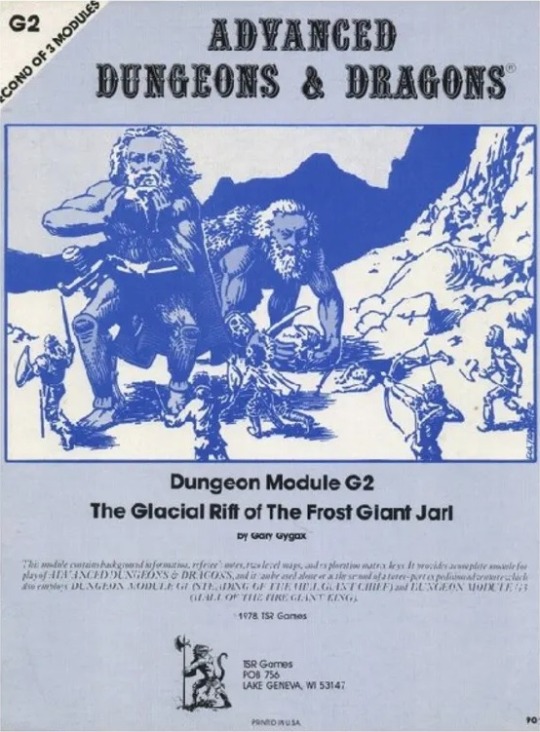
Coming out at the same time as G1 and G3, the adventures in the campaign which were just before and after it, Glacial Rift is a cool (literally) continuation of the Steading of the Hill Giant Chief. If that module was set in a boggy area against Hill Giants mainly, this one as you can tell from the title is set in a frozen environment. So we get Frost Giants and other cold appropriate monsters like Yetis, Remorhaz, Winter Wolves and Polar Bears as we go on with the mission of trying to figure out who is behind the Giant Alliance wreaking havoc throughout the region of Geoff (yes, really) in the Greyhawk setting.
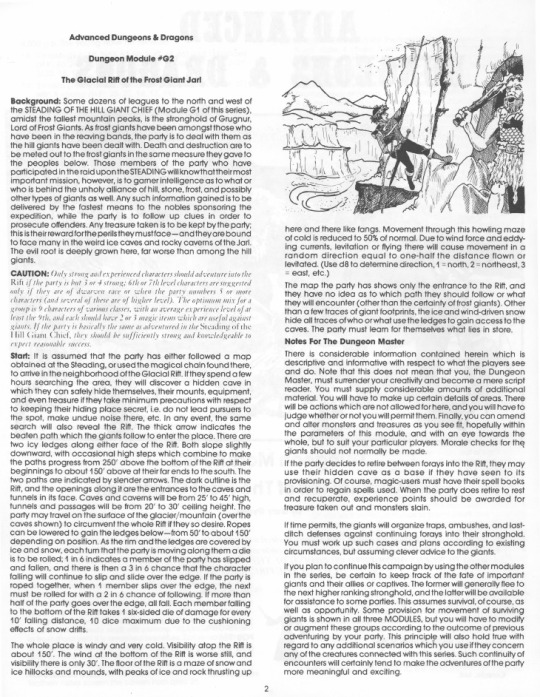
Like many middle portions of series, be they book or film trilogies, Glacial Rift also suffers from being a kind of bridging module, it doesn't have the same excitement as the first module, partly because less stuff is happening in the Rift than in the Steading which was having a great feast while the players were invading, but also because this is the second giant stronghold in a row that you are invading. Also because it's a middle module it can't give you any of the big reveals that are being saved for G3.

Still, it's a fun change of scenery for players and for a short 8 page adventure it's still pretty fun. It also has some good art by Trampier on the cover and in some of the interiors. Next time we will be looking at G3, Hall of the Fire Giant King, where there will be some surprising revelations, and the first appearance of a classic D&D race.
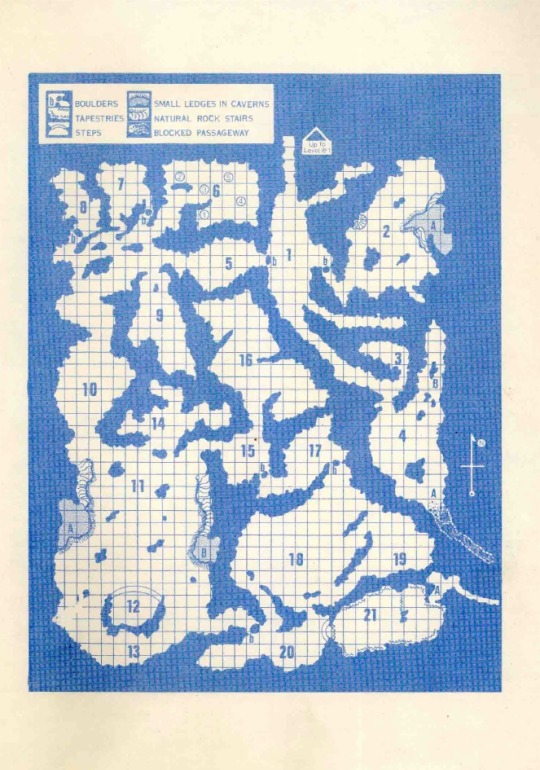
11 notes
·
View notes
Text
今日は午後からD&D第5版 Against the Giants から続きの The Glacial Rift of the Frost Jarl のセッション。D&D Beyond+Roll20+zoomボイチャ。キャラはハーフリング/ローグのギャレットで、レベル12になった。 #trpg #dnd #dndj #dnd5e

0 notes
Text
Queen Of The Spiders: The Greatest Adventure Of All Time...
Queen of the Spiders
Queen of the Spiders is a module published in 1986 and is a compilation of 7 related modules, often referred to as the "supermodule"!
Together, the seven adventures form an integrated campaign that begins in the World of Greyhawk, continues underground into the Underdark, and concludes in the Demonweb Pits, the abyssal lair of the demonic goddess Lolth.
What Is It About?
Giants have been raiding civilized lands in increasing numbers. The player characters have been called upon to combat the giants and to investigate the giants' reasons for invading and the strength of their forces.
The first module, Steading of the Hill Giant Chief, takes place in a gigantic wooden fort populated by hill giants and ogres. Here, the players uncover evidence of an alliance with other types of giants, as well as some mysterious letters from those behind the scenes.
In the second module, Glacial Rift of the Frost Giant Jarl, the action moves north to colder lands, where the setting is a system of caves clustered around a deep and narrow chasm in glacial ice. Here, the protagonists encounter frost giants, yeti and winter wolves, among other monsters.
The third module, Hall of the Fire Giant King, is set in a volcanic region where King Snurre has assembled a horde of fire giants, trolls and hell hounds. A secret passage from this module leads deep into the earth, where the adventurers discover the true nature of the force behind the raids – the drow in the service of Lolth, the demoness.
The fourth module, Descent into the Depths of the Earth, is on a larger scale than the others, with a map covering many kilometers of a deep underground region, later known as the Underdark. In the Underdark, there are many unique monsters previously unknown to surface adventurers, including the drow, which had been considered mythical. Troglodytes, jermlaine and svirfneblin (deep gnomes) made their first appearances in D&D literature in this module.
In the next module, Shrine of the Kuo-Toa, the adventurers explore a subterranean complex populated by the Kuo-toa, a race of fish-frog monsters in the service of the lobster goddess Blibdoolpoolp.
Players next make their way to the Vault of the Drow, a deep subterranean eldritch land in a huge cyst deep under the earth.
The adventure is completed with Queen of the Demonweb Pits. It takes place primarily in the eponymous Demonweb Pits, the 66th level of the Abyss.
Why Should I Use It?
Queen of the Spiders was ranked as the single greatest Dungeons & Dragons adventure of all time by Dungeon magazine, way back in 2004, and is probably still seen as the one of the greatest Dungeons & Dragons adventures of all time!
#adventure#adventures#dungeons and dragons#dungeons & dragons#dnd#d&d#community#comments#communityresponse#CreativeRogues
170 notes
·
View notes
Photo

1 note
·
View note